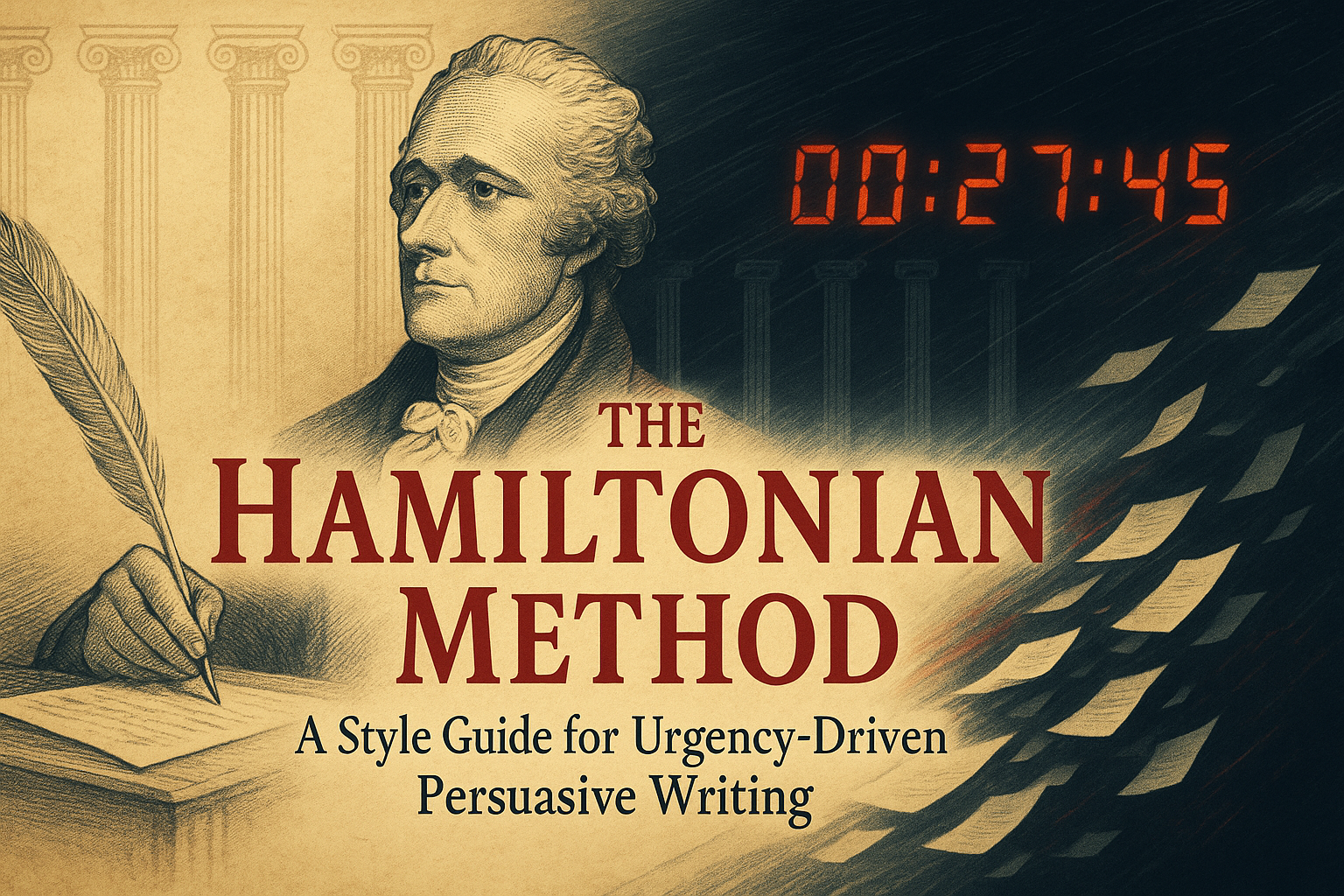The Hamiltonian Method: A Style Guide for Urgency-Driven Persuasive Writing
Hamilton understood that people act when standing still becomes more dangerous than moving forward. This guide codifies his techniques for modern writers who need to inspire immediate action.

Core Principle: Create Urgency Without Panic
Hamilton understood that people act when standing still becomes more dangerous than moving forward. This guide codifies his techniques for modern writers who need to inspire immediate action.
The Seven Pillars of Hamiltonian Persuasion
1. The Crisis Frame
Never warn about future problems. Reveal present catastrophes.
❌ Weak: "If we don't act, we might face difficulties ahead."
✅ Hamiltonian: "The collapse isn't coming—it's here, just unevenly distributed."
Techniques:
- Open with the patient already dying, not getting sick
- Use medical metaphors (heart attack, organ failure, metastasis)
- Frame every delay as active harm
- Make inaction feel like choosing disaster
Formula: [System] isn't [weakening]—it's [dying]. Like [vivid metaphor], every [specific delay] is another [fatal consequence].
2. Compressed Timelines
Make time visible, countable, and running out.
❌ Weak: "Eventually this will become a problem."
✅ Hamiltonian: "Q1 2025: Small businesses stop hiring. Q2: Mass layoffs begin. Q3: Credit markets freeze."
Techniques:
- Use specific dates, quarters, countdowns
- Show cascading consequences by timeframe
- Create "we are in Month 8 of 12" constructions
- Make readers feel they're watching a timer expire
Formula: By [specific date], [first consequence]. By [next date], [worse consequence]. Right now: [evidence it's already starting].
3. False Binaries
Eliminate middle ground. Present only two futures.
❌ Weak: "We have several options to consider."
✅ Hamiltonian: "Two paths remain. Only two. Those who promise a third way are selling fantasies."
Techniques:
- Explicitly deny gradual reform is possible
- Make both options painful but one clearly worse
- Use historical proof that no third option exists
- Force mental commitment to one path
Formula: History delivers its verdict: when [situation], only [Option A] or [Option B] remains. No exceptions. No appeals.
4. Personal Stakes
Transform abstract policy into human tragedy.
❌ Weak: "Regulatory burden is increasing."
✅ Hamiltonian: "Jennifer Martinez started as the solo compliance officer. Today she manages twelve. The company still employs 50 people making products."
Techniques:
- Name specific people (real or archetypal)
- Show career trajectories destroyed
- Detail daily frustrations
- Make readers see themselves in the stories
Formula: Meet [Name]. [Specific credentials/background]. Last [timeframe], they [specific action showing system failure]. "[Quote expressing frustration]." [Broader implication].
5. Competitive Pressure
Show others winning while we lose.
❌ Weak: "Other countries have different approaches."
✅ Hamiltonian: "China builds cities in months while we spend years on environmental impact studies."
Techniques:
- Use specific country comparisons with numbers
- Show it's not about traditional advantages
- Include mocking quotes from competitors
- Make patriotic pride demand action
Formula: [Competitor] achieves [impressive feat] in [short time] while we [fail slowly]. Not because of [traditional advantage]—because of [our self-imposed weakness].
6. Momentum Language
Write like an avalanche—mass in motion.
❌ Weak: "The situation may develop concerning trends."
✅ Hamiltonian: "The exodus accelerates. The builders flee. The window closes."
Techniques:
- Short, punching sentences
- Active voice always
- Present tense for future events
- Cascade of consequences in single paragraphs
- Use "already," "now," "accelerating"
Formula: [Subject] [active verb]. [Consequence] [intensifies]. [Time] [expires]. [Stakes] [multiply].
7. Information Asymmetry
Create insider knowledge that demands action.
❌ Weak: "Some experts believe..."
✅ Hamiltonian: "Those inside the system know it's already dead. Watch what they do, not what they say."
Techniques:
- Reference private conversations
- Point to elite preparations
- Reveal hidden indicators
- Make readers feel behind if not acting
Formula: [Insiders] already know [hidden truth]. Watch: [specific insider action]. They see what's coming because [they created it/have access].
Structural Techniques
Opening: The Immediate Crisis
- First sentence must make standing still feel dangerous
- No throat-clearing or context-setting
- Start with the wound, not the weapon
- Maximum impact in minimum words
Example Opening: "Your mind is under siege. Not metaphorically—measurably. Every scroll through your feed leaves neural pathways scarred, decision-making impaired, resistance weakened. The invaders aren't at the gates. They're in your pocket."
Building Momentum: The Cascade
Each paragraph should:
- Build on the previous crisis
- Add new evidence of acceleration
- Close another escape route
- Increase personal stakes
The Turn: From Diagnosis to Prescription
- Mark the shift clearly: "But here's what they don't want you to know..."
- Move from passive victim to active agent
- Provide specific, immediate actions
- Make preparation feel like victory
Closing: The Binary Choice
End with:
- Stark either/or proposition
- Time pressure ("Your answer determines...")
- Single word command ("Begin." "Choose." "Act.")
- Make inaction impossible
Language Patterns
Power Words for Each Pillar
Crisis Words: Collapse, suffocating, terminal, hemorrhaging, metastasis Time Words: Already, accelerating, daily, expires, vanishing Binary Words: Only, either, no third option, mathematical certainty Human Words: Meet, watch, explains, admits, fled Competition Words: Meanwhile, surpasses, captures, abandons Momentum Words: Cascades, compounds, accelerates, intensifies Insider Words: Privately, off-record, quietly, actually
Sentence Patterns
The Accumulation: "Every day, another X. Every week, another Y. Every month, another Z."
The Reveal: "This isn't about A. This is about B."
The Countdown: "Six months ago, X. Three months ago, Y. Last week, Z. Tomorrow?"
The Witness: "A [credible source] explains: '[Damning quote].'"
The Epitaph: "We're not [present action]. We're [fatal reality]."
Rhetorical Devices
The Hamiltonian Repetition
Repeat key phrases with building intensity:
- "Every day we delay costs us..."
- "The builders are leaving. The builders are leaving faster. The builders are gone."
- "Not tomorrow. Not after the election. Not when convenient. Now."
The Historical Echo
Use past collapse as present warning:
- "Rome didn't fall to barbarians—it fell to forms."
- "We're not approaching these cliffs—we've already driven off them."
The False Comfort Destruction
Acknowledge and demolish comforting beliefs:
- "Some will say this is alarmism. They mistake momentum for health."
- "The old measurements lie to us. GDP grows because..."
The Beautiful Paradox
Find the elegant contradiction that explains everything:
- "The cure became indistinguishable from the disease"
- "Victory through suicide"
- "We documented our decline with exquisite precision"
Common Mistakes to Avoid
❌ Academic Distance: "One might observe that..." → "Watch what happens when..."
❌ Hedging: "Perhaps we should consider..." → "Choose now or physics chooses for you"
❌ Abstract Villains: "The system" → "Michael Davidson, former regulator, now charges $500/hour"
❌ Vague Timelines: "Soon" → "By March 2025"
❌ Multiple Options: "Several paths forward" → "Two futures remain"
❌ Passive Voice: "Mistakes were made" → "They destroyed the economy"
❌ False Hope: "With effort we can reform" → "The window for reform closed in 2018"
The Hamiltonian Test
Before publishing, ask:
- Does the opening make readers feel immediate danger?
- Can readers see the clock ticking?
- Have I eliminated all middle ground?
- Will readers see themselves in the human stories?
- Do they feel others gaining while they lose?
- Is the language active and accelerating?
- Will they feel stupid for not already acting?
If any answer is no, revise with more urgency.
Example Paragraph Using All Seven Pillars
"The engineering exodus accelerates daily—fifteen thousand fled to consulting last year alone, trading creation for extraction because McKinsey pays triple what factories do. Sarah Chen, MIT's brightest, now packages debt into instruments so complex she laughs when asked to explain them. 'Nobody really knows,' she admits. Meanwhile, Singapore approves businesses in 24 hours while ours wait four months, minimum. The smart money already knows—watch the billionaire bunkers, the farmland grabs, the physical gold hoarding. We're not approaching the cliff—we stepped off it in 2018. Only momentum keeps us aloft. Two paths remain: controlled demolition or uncontrolled collapse. History provides no third option. Your choice determines which. Choose now. Build now. The alternative is darkness. Begin."
Final Principle: Write Like Civilization Depends on It
Because it might. Hamilton wrote like the American experiment hung in the balance because it did. Today's crises demand equal urgency. Every essay should feel like the last chance to warn, the final opportunity to inspire action.
The Hamiltonian writer doesn't comfort. Doesn't equivocate. Doesn't delay.
The Hamiltonian writer creates urgency that makes action inevitable.
Now go write like the future depends on it.
